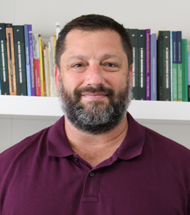research in the 2.0 era: a personalized digital adventure to learn about endangered linguistic traditions
Samuel Liebhaber, researcher of Middlebury College, presented his project of Humanities digital on the Mahri poetry of Yemen.

PHOTO: Natalia Rouzaut
The research is no longer published only on paper, it can also be digital native. This has been demonstrated by Samuel Liebhaber, researcher of Middlebury College (USA), who presented his project of Humanities digital called 'When melodies gather' during a seminar organized by the project 'Public discourse' of the Institute for Culture and Society (ICS) of the University of Navarra.
"The digital Humanities allows us to imagine new ways of expressing academic narrative and visualizing the data", said the researcher. Liebhaber is an expert in Arabic literature and researches the poetic tradition of the Mahra, a Yemeni community of about 200,000 members whose language is exclusively oral. "The composition of their poetry is based purely on a purely oral cognitive and psychological experience," he explained.
How is it possible to show on a academic publication the richness of Mahri poetry without remaining a mere transcription? Liebhaber worked with a team of technicians from his own university, Middlebury College, and from publishing house Stanford University Press and presented his research from a new angle: purely digital.
His publication 'When melodies gather' has a web format that can be navigated interactively, accessing information according to one's own interests Username. According to the author, this interactivity enhances engagement with the knowledge as "you can personalize the meeting with the research in a way that is not possible in a printed monograph".
However, the expert does not believe that the digital Humanities will displace the paper research . He believes that both can coexist and support each other.
An example of coexistenceTo support the possibility of coexistence between two different formats, he proposed the example of the Mahri language. The Mahra population is a small stronghold in the Arab world and its entire population is bilingual: it uses Arabic for writing, in educational institutions and in the media and, in turn, has maintained the tradition of the language Mahri.
The expert pointed out that the younger generations have become accustomed to using Arabic as it is more useful in their daily lives. This could endanger the preservation of this language since, if the generational transmission is broken, the issue of speakers would be drastically reduced.
However, Liebhaber has assured that, in his interviews with the Mahra, this population did not feel the Arab as an invasive language nor did they see their language in danger of extinction. He stated that the Mahra are "proud of their Arabic heritage and their extraordinary language on the same level as they are proud of the language Mahri". As he explained, both linguistic traditions have managed to blend to the point of finding a balance "that changes from generation to generation".
Thus, the researcher believes that the Mahra are an example for other bilingual communities, showing that having two languages does not have to be a problem of coexistence. "The Mahra offer us a linguistic model in which two different languages coexist without the need for a sense of crisis or conflict between them," he concluded.
The expert spoke about these issues at the framework of the project Marie Skłodowska-Curie 'Locked between formulas: creativity in oral and transitional poetic texts'(ORFORCREA), funded by the European Union's Horizon 2020 program (2017-2019; project 749952).





